Listed below are some of the dieties in Shri Hemadurga Temple
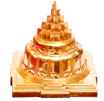 Sri Chakram Meru:
Sri Chakram Meru: In Hindu devotional practice, three kinds of external symbols are used for worship of the Supreme Being, who is actually formless and nameless. The most external is that of divine images cast in human form, with paraphernalia symbolizing supra-human divinity.
The most subtle is that of the mantras or divine names with certain sounds. A mantra is divine power clothed in sound. Between these two come the yantras or chakras , representing the deity in geometrical diagrams. Worshippers of Shakti consider the Srichakra the holiest and most significant of divine symbols.
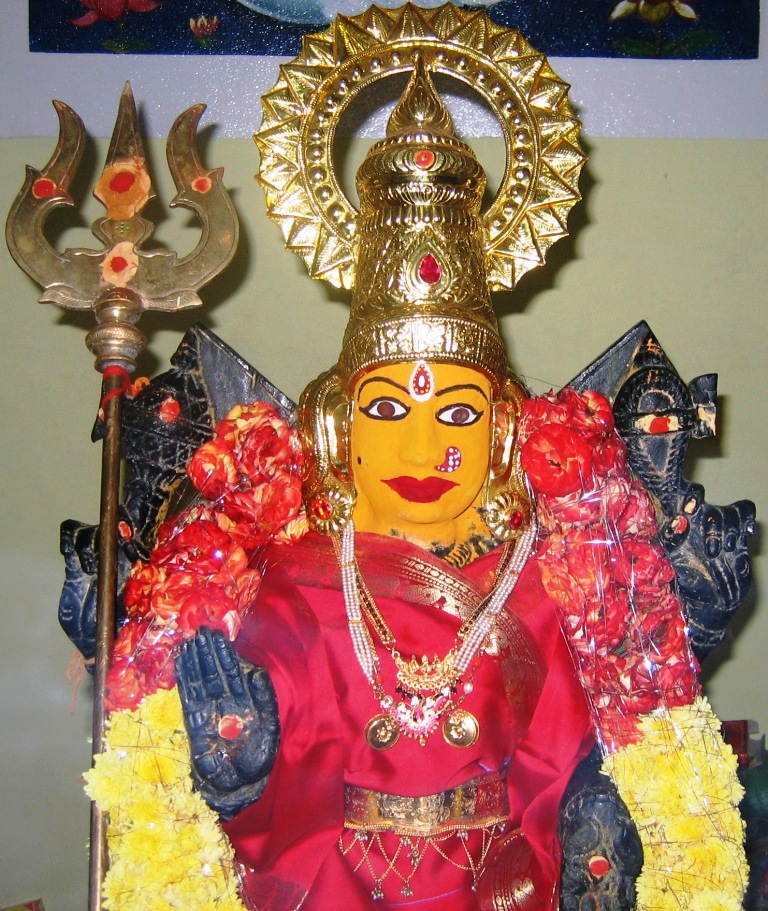 Hema Durga:
Hema Durga: Goddess Durga is the mother of the universe and believed to be the power behind the work of creation, preservation, and destruction of the world. Since time immemorial she has been worshipped as the supreme power of the Supreme Being and has been mentioned in many scriptures - Yajur Veda, Vajasaneyi Samhita and Taittareya Brahman.
The word "Durga" in Sanskrit means a fort, or a place which is difficult to overrun. Another meaning of "Durga" is "Durgatinashini," which literally translates into "the one who eliminates sufferings." Thus, Hindus believe that goddess Durga protects her devotees from the evils of the world and at the same time removes their miseries.
 Lakshmi:
Lakshmi: Lakshmi is depicted as a beautiful woman of golden complexion, with four hands, sitting or standing on a full-bloomed lotus and holding a lotus bud, which stands for beauty, purity and fertility. Her four hands represent the four ends of human life:dharma or righteousness, "kama" or desires, "artha" or wealth, and "moksha" or liberation from the cycle of birth and death.
Cascades of gold coins are seen flowing from her hands, suggesting that those who worship her gain wealth. She always wears gold embroidered red clothes. Red symbolizes activity and the golden lining indicates prosperity. Lakshmi is the active energy of Vishnu, and also appears as Lakshmi-Narayan - Lakshmi accompanying Vishnu.
Two elephants are often shown standing next to the goddess and spraying water. This denotes that ceaseless effort, in accordance with one's dharma and governed by wisdom and purity, leads to both material and spiritual prosperity.
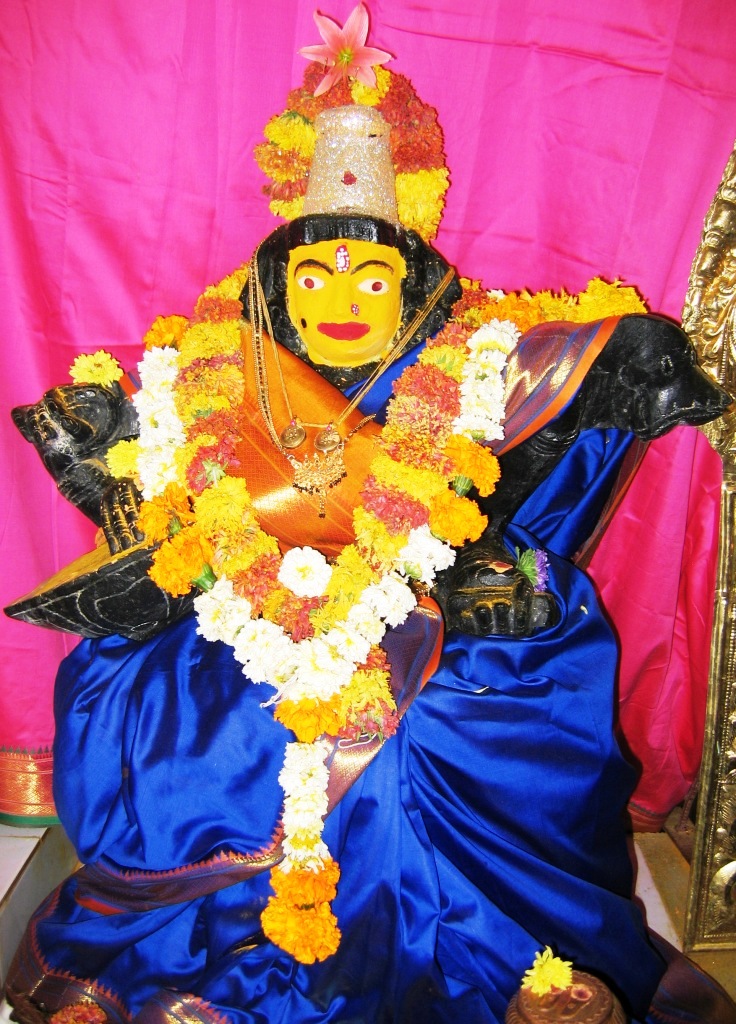 Saraswathi:
Saraswathi: Saraswati, the goddess of knowledge and arts, represents the free flow of wisdom and consciousness. She is the mother of the Vedas, and chants to her, called the 'Saraswati Vandana' often begin and end Vedic lessons.
She has four hands representing four aspects of human personality in learning: mind, intellect, alertness and ego. She has sacred scriptures in one hand and a lotus – the symbol of true knowledge – in the second.
With her other two hands she plays the music of love and life on a string instrument called the veena. She is dressed in white – the symbol of purity – and rides on a white swan – symbolizing Sattwa Guna or purity and discrimination. Saraswati is also a prominent figure in Buddhist iconography - the consort of Manjushri.
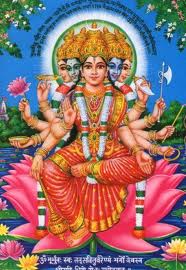 Gayathri
Gayathri Devi symbolises the "shakti" (strength) and "dev" (quality) of Knowledge, Purity and Virtue. Gayatri Devi is believed to have given the four Vedas to mankind. Gayatri is depicted seated on a lotus. She is depicted with five faces representing the pancha pranas /pancha vayus(five lives/winds): prana, apana,vyana, udana, samana, of the five principles/ elements (pancha tatwas) earth, water, air, fire, sky (prithvi, jala, vayu, teja, aakasha). She has 10 hands carrying the five ayudhas: shankha; chakra, kamala, varada, abhaya, kasha, ankusha, ujjwala utensil, rudrakshi mala.
Gayatri mantra In Sanskrit, there are definite rules that regulate poetry: rhyme and meter are not written whimsically. The Gayatri Mantra has a Vedic metre of 24 syllables. Amongst the regulated poetry, the Gayatri mantra, chanted by properly qualified persons, is the most prominent. The Gayatri mantra is mentioned in the Srimad Bhagavatam. Great sins are said to be expiated by a pious recitation of this Gayatri verse which reads as follows:
Om bhoor bhuvah svaha,
Tat Savitur varenyam,
Bhargo devasya dheemahi,
Dheeyo yonah prachodayat.
Gayatri mantra is meant for realization of God and is regarded as representing the Supreme Lord. It is meant for spiritually advanced people. Success in chanting it enables one to enter the transcendental position of the Lord. But, in order to chant the Gayatri mantra, it is necessary for one to first acquire the qualities of the perfectly balanced person in terms of the qualities of goodness according to the laws of material nature.
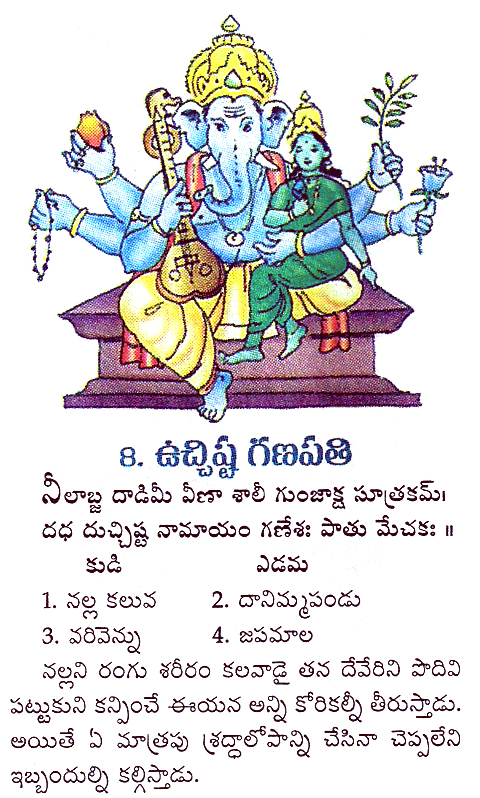 Ucchista Ganapathi
Ucchista Ganapathi is a very rare form of Ganesha and is also included in the 32 forms of Ganapathy. This form of Ganesh is worshipped for protection and also for getting control over the five senses. Ucchishta Ganapati Mantra is
Neelabja dadaimee veena shali gujaksha sutrakam
Dadahduchishta namamya ganeshah paadu mechakah!
Ucchishta Ganapati depicted in deep blue color. He has six hands and holds a pomegranate fruit, veena, flower, paddy, Rudraksha mala and noose. A Goddess sits on his left lap. The popular belief is that propitiating this form Ganesha will help in control of the five senses and which in return will help in attaining peace and prosperity.
Updqate on other deities to follow soon....